Alcázar of Segovia
| Alcázar of Segovia | |
|---|---|
| Segovia, Castile and León | |
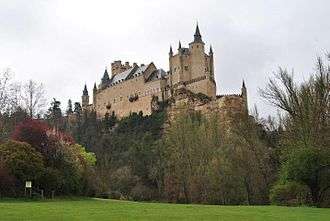 | |
 Alcázar of Segovia | |
| Coordinates | 40°57′09″N 4°07′58″W / 40.9525°N 4.132778°W |
The Alcázar of Segovia (literally, "Segovia Fortress") is a castle, located in the old city of Segovia, Spain. Rising out on a rocky crag above the confluence of two rivers near the Guadarrama mountains, it is one of the most distinctive castle-palaces in Spain by virtue of its shape – like the bow of a ship. The Alcázar was originally built as a fortress but has served as a royal palace, a state prison, a Royal Artillery College and a military academy since then. It is currently used as a museum and a military archives building.
History
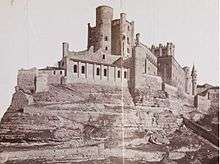
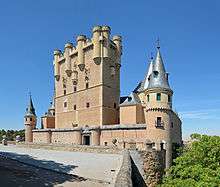
The Alcázar of Segovia, like many fortifications in Spain, started off as Roman fort, but apart from the foundations, little of the original structure remains. A Muslim era fort, which was itself largely replaced by the present structure, was built by the Berber Almoravid dynasty. The first reference to this particular "alcázar" was in 1120, around 32 years after the city of Segovia returned to Christian hands (during the time when King Alfonso VI reconquered lands to the south of the Duero river down to Toledo and beyond).
The shape and form of the Alcázar was not known until the reign of King Alfonso VIII (1155–1214), however early documentation mentioned a wooden stockade fence. It can be concluded that prior to Alfonso VIII's reign, the Muslim era structure was no more than a wooden fort built over the old Roman foundations. Alfonso VIII and his wife, Eleanor of England, made this alcázar their principal residence and much work was carried out to erect the beginnings of the stone fortification we see today.
The Alcázar of Segovia was one of the favorite residences of the monarchs of Castile in the Middle Ages, and a key fortress in the defence of the kingdom. It was during this period that most of the current building was constructed by the Trastámara dynasty.
In 1258, parts of the Alcázar had to be rebuilt by King Alfonso X after a cave-in and soon after the Hall of Kings was built to house Parliament. However, the single largest contributor to the continuing construction of the Alcázar is King John II who built the "New Tower" (John II tower as it is known today).
In 1474, the Alcázar played a major role in the rise of Queen Isabella I. On 12 December news of the King Henry IV's death in Madrid reached Segovia and Isabella immediately took refuge within the walls of this Alcázar where she received the support of Andres Cabrera and Segovia's council. She was enthroned the next day as Queen of Castile and León.
The next major renovation at the Alcázar was conducted by King Philip II after his marriage to Anna of Austria. He added the sharp slate spires to reflect the castles of central Europe. In 1587, architect Francisco de Morar completed the main garden and the School of Honor areas of the castle.
The royal court eventually moved to Madrid and the Alcázar then served as a state prison for almost two centuries before King Charles III founded the Royal Artillery School in 1762. It served this function for almost a hundred years until 6 March 1862 where a fire badly damaged the roofs of the treasury, keep, armory, sleeping quarters, and framework.
It was only in 1882 that the building was slowly restored to its original state. In 1896, King Alfonso XIII ordered the Alcázar to be handed over to the Ministry of War as a military college.
Interior
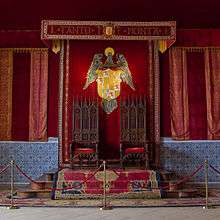
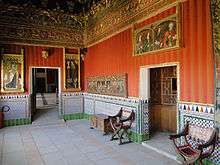
According to The Illustrated Magazine of Art (1853)[1]
The interior of the Castle of Segovia is in perfect accordance with the magnificence of its exterior. Many apartments are decorated with delicate traceries and pendant ornaments, in the style of the Alhambra, and, like those of the Alcazar of Seville, were executed by Arabian workmen during the Christian dominion of the fourteenth century, for in many places the crowns of the kings of Castille may be seen, surrounded by Latin mottoes [sic] and extracts from the Koran.
The original interior was badly damaged by fire in 1862, though it has since been partially restored.[2] Today, the Alcázar remains one of the most popular historical sites in Spain and is one of the three major attractions in Segovia. Notable rooms are the Hall of Ajimeces which houses many works of art, the Hall of the Throne and the Hall of Kings with a frieze representing all of the Spanish Kings and Queens starting from Pelagius of Asturias down to Juana la Loca after moving to El Palacio Real in Madrid, Spain.
In popular culture
The castle was one of the inspirations for Walt Disney's Cinderella Castle. The castle also served as the French home of Sir Lancelot du Lac, Joyous Gard, in the 1967 musical film "Camelot".
References
Further reading
- Haliczer, Stephen (December 1976), "Political Opposition and Collective Violence in Segovia, 1475–1520", The Journal of Modern History, 48 (4): 1–35, doi:10.1086/241530, JSTOR 1877303
External links
![]() Media related to Alcázar of Segovia at Wikimedia Commons
Media related to Alcázar of Segovia at Wikimedia Commons
- Castillos de España (Alcazar de Segovia)
- Alcázar de Segovia Information and Photos.
- Entry in Great Buildings website - Alcázar of Segovia.
- Alcázar of Segovia photos and history
